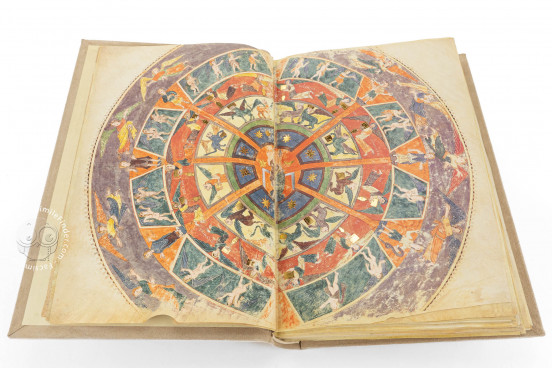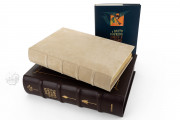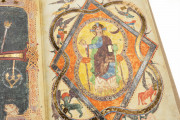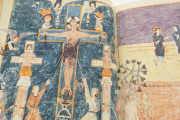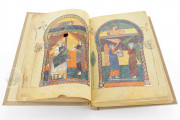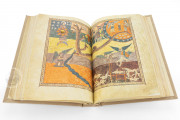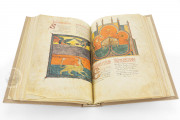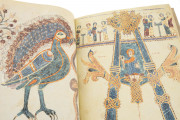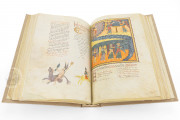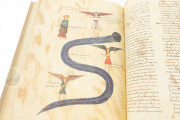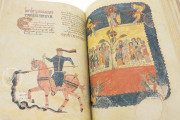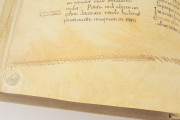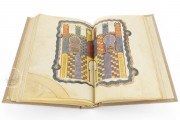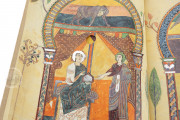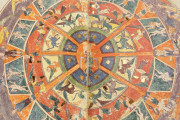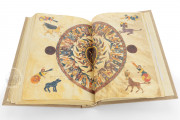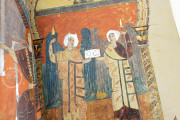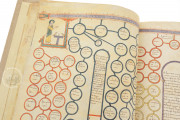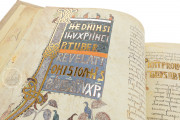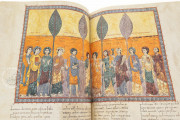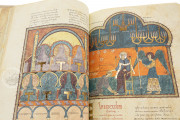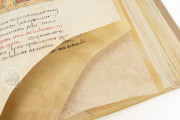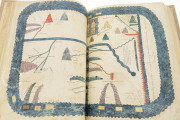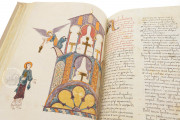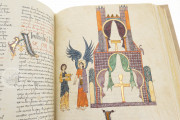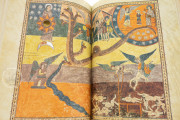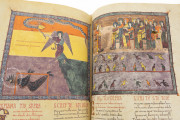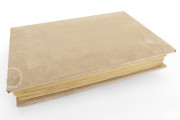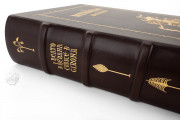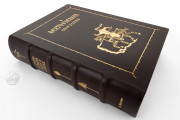Created at the height of the production of illuminated manuscripts of Beatus of Liébana's commentary on the Christian biblical book of the Apocalypse, the Girona Codex is the most elaborately illuminated copy surviving from the rich tradition. Made probably at the monastery of San Salvador de Tábara and completed in 975, the manuscript features a series of prefatory paintings in a variety of formats, eighty-one illustrations of the Apocalypse, and ten illustrations of the Old Testament prophecy of Daniel, applying a wide ornamental vocabulary and making liberal use of both gold and silver.
The manuscript's prefatory illumination includes a page with an ornamental cross (fol. 1v), a miniature of Christ in Majesty (fol. 2r), a representation of heaven that extends across two facing pages (fols. 3v-4r), portraits of the authors of the Gospels facing miniatures of angels (fols. 4v-7r), fourteen pages of illustrated genealogy (fols. 8v-15r), and six miniatures with Christological scenes (fols. 15r-18r).
An Expanded Visual Cycle
Although it stands firmly in the tradition of illuminated Beatus codices manifested in earlier manuscripts such as the Valladolid Codex, the Girona Codex has unique features. The series of Christological scenes of one, two, or three to a page—which is without parallel in the Beatus tradition—extends from the Adoration of the Magi to the Rejoicing at the Resurrection of the Dead. Also unusual is the two-page schematic view of Heaven.
En and Emeterius
At the bottom of a page dedicated to a large interlace Greek letter omega (fol. 284r), a colophon written in elaborate display script on a painted ground reveals the identities of people associated with the manuscript's production: "En, painter [depintrix] and helper of God; Emeterius, brother and father."
The Latin makes clear that En was a woman. She may have been a nun, but she might also have been an elite woman with no official ties to the monastery. The Latin depintrix could have meant either painter or scribe in Spain at the time, and it is possible that she was a patron rather than an active participant in the creation of the codex.
Emeterius is also named in the Tábara Codex, together with his teacher Maius. An inscription in display script at the top of the omega page informs us that Abbot Domenicus had the manuscript made, and another inscription at the bottom of the page reports that it was completed on July 6, 975.
A Storied Text
The commentary on the Apocalypse contained in the Girona Codex was written by Beatus of Liébana in the eighth century. The text of the Apocalypse is divided into sixty-eight sections called storiae. Each passage of scripture is followed by Beatus's commentary (called an explanatio) that offers symbolic interpretations and allegories of the biblical text.
The Girona Codex, in keeping with tradition, also includes a commentary by Saint Jerome on the Old Testament prophecy of Daniel. There are plentiful inscriptions in the miniatures. All the text is in Latin.
Visigothic Minuscule
At the end of the text (fol. 283v), the scribe, a priest named Senior, signed his work in display capitals. Senior wrote his text in Visigothic Minuscule. Several elegant display scripts in red and black, along with painted initials highlighted in gold, enliven the presentation of the text.
From a "Frontier" Monastery
The Girona Codex is one of three Beatus manuscripts linked to the scriptorium at the monastery of San Salvador de Tábara, located in the northwest of modern-day Spain. The manuscript appears to have moved to the other side of the peninsula not long after its creation. It was donated in 1078 to the cathedral of Girona (in Catalonia, northeast of Barcelona) by one Johannes.
_____
For more information on the Beatus model, read our blog article by Amy R. Miller (PhD, Medieval Art History, University of Toronto).
We have 2 facsimiles of the manuscript "Beatus of Liébana - Girona Codex":
- Beati in Apocalipsin Libri Duodecim facsimile edition published by Edilan, 1975
- Beato de Liébana, Códice de Girona facsimile edition published by M. Moleiro Editor, 2003

